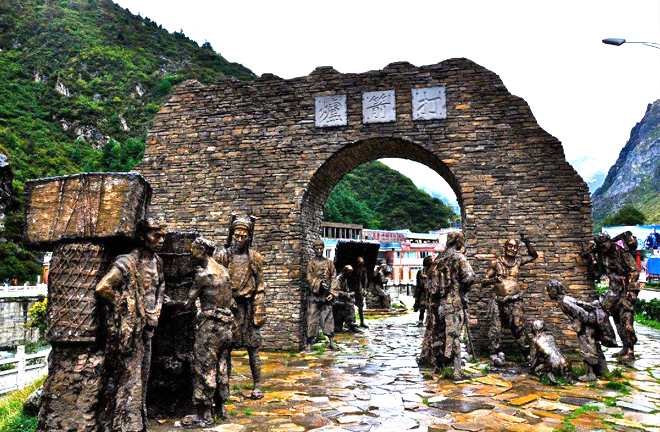Han-Tibetan exchanges in transportation, materials, trade

The Tea Horse Road passed across Dajianlu region, now Kangding County in Sichuan Province, and was essential to Han-Tibetan exchanges throughout history.
The evolution of transportation networks, material circulation, economics and trade are important research fields in the history of Han-Tibetan exchanges. The International Symposium on “Han-Tibetan exchanges: Transportation, Materials and Trade” hosted by the Institute of Tibetan Studies of Sichuan University, was held in Sichuan University on Oct. 21 and 22.
Not an isolated bastion of culture
Huo Wei, director of the Institute of China Tibetology at Sichuan University, highlighted new research achievements regarding the Plateau Silk Road. He said that in recent years, archaeological discoveries have revealed that the Qinghai-Tibet Plateau was not an isolated bastion of culture. Since the prehistoric era, it has had close exchanges and contact with neighboring countries and regions.
Huo said that the historic significance of the Plateau Silk Road constitutes an important part of the Silk Road network that embodies the cultural exchanges between China and foreign countries. The Silk Road network was the main channel for the spread of the culture of the Central Plains in ancient China. It served as a transit station and distribution center for cultural exchanges between China and foreign countries. In addition, it played a special role in the formation of Tubo society and Tubo civilization.
Ba Sang Wangdui, a research fellow from the Academy of Social Sciences of Tibet Autonomous Region, analyzed historical data of Han-Tibetan transport links in Tibetan historical materials. He said that there are many precious historical materials in the Tibetan literature, especially monk biographies, concerning the transport aspects of the exchanges. Most of these monks traveled to the Central Plains to make a significant contribution to the formation of a multi-ethnic and unified China and the cultural exchanges between the Central Plains and Tibetan Regions. Their biographies involve the routes to the Central Plains, leaving valuable clues for the study of historic Han-Tibetan channels.
Zhang Yun, director of the Institute of History at the China Tibetology Research Center, uses a case study approach to study the material and cultural exchanges between the inland and Tibet through Chinese loan words in Tibetan. Based on his predecessors’ research, he has conducted a preliminary analysis of a number of terms and related issues. In his opinion, language is the carrier of cultural exchanges. During the continuous material and cultural exchanges between the Central Plains and Tibet, Chinese and Tibetan languages have been enriched and developed. There are many Chinese words borrowed from the Tibetan language, some of which can show the historical imprint of material and cultural exchanges.
Shi Shuo, deputy director of the Institute of China Tibetology at Sichuan University, analyzed the pioneering path into the Tibetan area through the Dajianlu region (now Kangding County, Sichuan Province) in the Qing Dynasty. Shi argues that in the process of establishing direct dominance over Tibet by the Qing government, the road to Tibet through Dajianlu was of crucial significance. While building the road, the Qing Dynasty strengthened its control over the broader Sichuan-Tibetan region.
Tea trade, transporation
Research on Han-Tibetan tea trade and transport networks was one of the hot topics of the conference. Scholars discussed the time and routes of the introduction of tea into Tibet, and related new archaeological materials.
Matthew Kapstein, head of research at the École Pratique des Hautes Études, analyzed the growth of tea trade and the development of monasteries in the 12th century in the Sichuan-Tibet area. He argued that the growing tea trade economically supported the establishment of the monastery center in the region.
Liu Zhiyang, director of the Department of Anthropology at Sun Yat-sen University, said that in the Tang Dynasty, there appeared records of tea in the Tibetan literature. The popularity of tea in the Tibet Autonomous Region began in the Song Dynasty. In the Ming and Qing dynasties, tea became an indispensable necessity for Tibetans. Historically, tea was transported on a huge network of roads with the main roads of Sichuan Road, Yunnan Road and Qingzang Road (Gan Qing Road) supplemented by a large number of branch lines and attached lines that stretched across Sichuan, Yunnan, Shaanxi, Gansu, Qinghai provinces and the Tibetan Autonomous Region, extending outward to South Asia, Southeast Asia, Central Asia and West Asia.

 PRINT
PRINT CLOSE
CLOSE